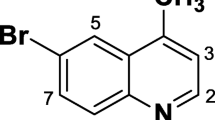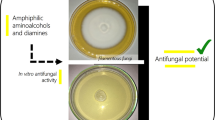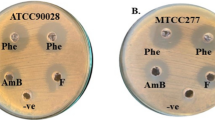Abstract
The scarce antifungal arsenal, changes in the susceptibility profile of fungal agents, and lack of adherence to treatment have contributed to the increase of cases of dermatomycoses. In this context, new antimicrobial substances have gained importance. Chalcones are precursors of the flavonoid family that have multiple biological activities, have high tolerability by humans, and easy synthesis. In this study, we evaluated the in vitro antifungal activity, alone and in combination with conventional antifungal drugs, of the VS02–4′ethyl chalcone-derived compound against dermatophytes and Candida spp. Susceptibility testing was carried out by broth microdilution. Experiments for determination of the target of the compound on the fungal cell, time-kill kinetics, and toxicity tests in Galleria mellonella model were also performed. Combinatory effects were evaluated by the checkerboard method. Results showed high activity of the compound VS02–4′ethyl against dermatophytes (MIC of 7.81–31.25 μg/ml). The compound targeted the cell membrane, and the time-kill test showed the compound continues to exert gradual activity after 5 days on dermatophytes, but no significant activity on Candida. Low toxicity was observed at 250 mg/kg. Excellent results were observed in the combinatory test, where VS02–4′ethyl showed synergistic interactions with itraconazole, fluconazole, terbinafine, and griseofulvin, against all isolates tested. Although further investigation is needed, these results revealed the great potential of chalcone-derived compounds against fungal infections for which treatments are long and laborious.



Similar content being viewed by others
Data availability
No datasets were generated or analysed during the current study.
References
Ahmad A, Wani MY, Patel M, Sobral AJFN, Duse AG, Aqlan FM, Al-Bogami AS (2017) Synergistic antifungal effect of cyclized chalcone derivatives and fluconazole against Candida albicans. Medchemcomm 8:2195–2207. https://doi.org/10.1039/c7md00440k
Appelt L, Nenoff P, Uhrlaß S, Krüger C, Kühn P, Eichhorn K, Buder S, Beissert S, Abraham S, Aschoff R, Bauer A (2021) Terbinafin-resistente Dermatophytosen und Onychomykose durch Trichophyton rubrum [Terbinafine-resistant dermatophytoses and onychomycosis due to Trichophyton rubrum]. Hautarzt 72:868–877. https://doi.org/10.1007/s00105-021-04879-1
Ayaz M, Ullah F, Sadiq A, Ullah F, Ovais M, Ahmed J, Devkota HP (2019) Synergistic interactions of phytochemicals with antimicrobial agents: potential strategy to counteract drug resistance. Interactions 308:294–303. https://doi.org/10.1016/j.cbi.2019.05.050
Baghi N, Shokohi T, Badali H, Makimura K, Rezaei-Matehkolaei A, Abdollahi M, Didehdar M, Haghani I, Abastabar M (2016) In vitro activity of new azoles luliconazole and lanoconazole compared with ten other antifungal drugs against clinical dermatophyte isolates. Med Mycol 54(7):757–763. https://doi.org/10.1093/mmy/myw016
Beardsley J, Halliday CL, Chen SC, Sorrell TC (2018). Responding to the emergence of antifungal drug resistance: perspectives from the bench and the bedside. Future Microbiol 13(10). https://doi.org/10.2217/fmb-2018-0059
Brescini L, Fioriti S, Morroni G, Barchiesi F (2021) Antifungal combinations in dermatophytes. J Fungi 7(9):727. https://doi.org/10.3390/jof7090727. (Basel)
Browne N, Heelan M, Kavanagh K (2013) An analysis of the structural and functional similarities of insect hemocytes and mammalian phagocytes. Virulence 4(7):597–603. https://doi.org/10.4161/viru.25906
Cantelli BAM, Bitencourt TA, Komoto TT, Beleboni RO, Marins M, Fachin AL (2017) Caffeic acid and licochalcone A interfere with the glyoxylate cycle of Trichophyton rubrum. Biomed Pharmacother 16:1389–1394. https://doi.org/10.1016/j.biopha.2017.11.051
Chai N, Sun A, Zhu X, Li Y, Wang R, Zhang Y, Mao Z (2023) Antifungal evaluation of quinoline-chalcone derivatives combined with FLC against drug-resistant Candida albicans. Bioorg Med Chem Lett 86:129242. https://doi.org/10.1016/j.bmcl.2023.129242
Ciesielska A, Kawa A, Kanarek K, Soboń A, Szewczyk R (2021). Metabolomic analysis of Trichophyton rubrum and Microsporum canis during keratin degradation. Sci Rep 11(3959). https://doi.org/10.1038/s41598-021-83632-z
CLSI (2008) Reference Method for Broth Dilution Antifungal Susceptibility Testing of Yeasts, 3rd edn CLSI standard M27-3rd. Clin Lab Stand Inst, Wayne, PA
CLSI (2017) Reference method for broth dilution antifungal susceptibility testing of filamentous fungi, 3rd edn. CLSI standard M38-3rd. Clin Lab Stand Inst, Wayne, PA
Corralo DS, Heras-Alonso ME, Acebes LO (2014) Infecciones cutáneas. Medicine 11(47):2755–2763. https://doi.org/10.1016/S0304-5412(14)70694-8
De Castro RD, de Souza TM, Bezerra LM, Ferreira GL, Costa EM, Cavalcanti AL (2015) Antifungal activity and mode of action of thymol and its synergism with nystatin against Candida species involved with infections in the oral cavity: an in vitro study. BMC Complement Altern Med 15(417). https://doi.org/10.1186/s12906-015-0947-2
Dhingra S, Rahman NAA, Peile E, Rahman M, Sartelli M, Hassali MA, Islam T, Islam S, Haque M (2020) Microbial resistance movements: an overview of global public health threats posed by antimicrobial resistance, and how best to counter. Front Public Health 8:535668. https://doi.org/10.3389/fpubh.2020.535668
Dos Santos MB, Pinhanelli VC, Garcia MAR, Silva G, Baek SJ, França SC, Fachin AL, Marins M, Regasini LO (2017) Antiproliferative and pro-apoptotic activities of 2′- and 4′-aminochalcones against tumor canine cells. Eur J Med Chem 29(138):884–889. https://doi.org/10.1016/j.ejmech.2017.06.049
Dos Santos MB, Bertholin Anselmo D, de Oliveira JG, Jardim-Perassi BV, Alves Monteiro D, Silva G, Gomes E, Lucia Fachin A, Marins M, de Campos Zuccari DAP, Octavio Regasini L (2019) Antiproliferative activity and p53 upregulation effects of chalcones on human breast cancer cells. J Enzyme Inhib Med Chem 34(1):1093–1099. https://doi.org/10.1080/14756366.2019.1615485
Dos Santos ATL, de Araújo-Neto JB, Costa da Silva MM, Paulino da Silva ME, Carneiro JNP, Fonseca VJA, Coutinho HDM, Bandeira PN, Dos Santos HS, da Silva Mendes FR, Sales DL, Morais-Braga MFB (2023) Synthesis of chalcones and their antimicrobial and drug potentiating activities. Microb Pathog 180:106129. https://doi.org/10.1016/j.micpath.2023.106129
Dos Santos Ramos MA, de Toledo LG, Calixto GM, Bonifácio BV, de Freitas Araújo MG, Dos Santos LC, de Almeida MT, Chorilli M, Bauab TM (2016) Syngonanthus nitens Bong. (Rhul.)-loaded nanostructured system for vulvovaginal candidiasis treatment. Int J Mol Sci 17(8):1368. https://doi.org/10.3390/ijms17081368
Dunaiski CM, Kock MM, Chan WY, Ismail A, Peters RPH (2024) Molecular epidemiology and antimicrobial resistance of vaginal Candida glabrata isolates in Namibia. Med Mycol 62(2):myae009. https://doi.org/10.1093/mmy/myae009
Duran N, Polat MF, Aktas DA, Alagoz MA, Ay E, Cimen F, Tek E, Anil B, Burmaoglu S, Algul O (2021) New chalcone derivatives as effective against SARS-CoV-2 agent. Int J Clin Pract 75(12):e14846. https://doi.org/10.1111/ijcp.14846
Escalante A, Gattuso M, Pérez P, Zacchino S (2008) Evidence for the mechanism of action of the antifungal phytolaccoside B isolated from Phytolacca tetramera Hauman. J Nat Prod 71(10):1720–1725. https://doi.org/10.1021/np070660i
Frías-De-León MG, Hernández-Castro R, Conde-Cuevas E, García-Coronel IH, Vázquez-Aceituno VA, Soriano-Ursúa MA, Farfán-García ED, Ocharán-Hernández E, Rodríguez-Cerdeira C, Arenas R, Robledo-Cayetano M, Ramírez-Lozada T, Meza-Meneses P, Pinto-Almazán R, Martínez-Herrera E (2021) Candida glabrata antifungal resistance and virulence factors, a perfect pathogenic combination. Pharmaceutics 13:1529. https://doi.org/10.3390/pharmaceutics13101529
Ghannoum M (2016) Azole resistance in dermatophytes: prevalence and mechanism of action. J Am Podiatr Med Assoc 106(1):79–86. https://doi.org/10.7547/14-109
Gładkowski W, Siepka M, Żarowska B, Białońska A, Gawdzik B, Urbaniak M, Wawrzeńczyk C (2023) Chalcone-derived lactones: synthesis, whole-cell biotransformation, and evaluation of their antibacterial and antifungal activity. Molecules 28(9):3800. https://doi.org/10.3390/molecules28093800
Gupta AK, Stec N (2019) Recent advances in therapies for onychomycosis and its management. F1000Res 8(F1000 Faculty Rev):968. https://doi.org/10.12688/f1000research.18646.1
Gupta AK, Venkataraman M (2022) Antifungal resistance in superficial mycoses. J Dermatolog Treat 33(4):1888–1895. https://doi.org/10.1080/09546634.2021.1942421
Gupta AK, Renaud HJ, Quinlan EM, Shear NH, Piguet V (2021) The growing problem of antifungal resistance in onychomycosis and other superficial mycoses. Am J Clin Dermatol 22:149–157. https://doi.org/10.1007/s40257-020-00580-6
Hellewell L, Bhakta S (2020) Chalcones, stilbenes and ketones have anti-infective properties via inhibition of bacterial drug-efflux and consequential synergism with antimicrobial agents. Access Microbiol 2(4):acmi000105. https://doi.org/10.1099/acmi.0.000105
Ignasiak K, Maxwell A (2017) Galleria mellonella (greater wax moth) larvae as a model for antibiotic susceptibility testing and acute toxicity trials. BMC Res Notes 10(428). https://doi.org/10.1186/s13104-017-2757-8
Jesus A, Durães F, Szemerédi N, Freitas-Silva J, da Costa PM, Pinto E, Pinto M, Spengler G, Sousa E, Cidade H (2022) BDDE-inspired chalcone derivatives to fight bacterial and fungal infections. Mar Drugs 20(5):315. https://doi.org/10.3390/md20050315
Kaan Ö, Koç AN, Atalay MA, Mutlu Sarigüzel F (2021) Molecular epidemiology, antifungal susceptibility and virulence factors of Candida glabrata complex strains in Kayseri/Turkey. Microb Pathog 154:104870. https://doi.org/10.1016/j.micpath.2021.104870
Ketabforoosh SH, Kheirollahi A, Safavi M, Esmati N, Ardestani SK, Emami S, Firoozpour L, Shafiee A, Foroumadi A (2014) Synthesis and anti-cancer activity evaluation of new dimethoxylated chalcone and flavanone analogs. Arch Pharm 347(11):853–860. https://doi.org/10.1002/ardp.201400215. (Weinheim)
Klepser ME, Ernst EJ, Lewis RE, Ernst ME, Pfaller MA (1998) Influence of test conditions on antifungal time-kill curve results: proposal for standardized methods. Antimicrob Agents Chemother 42(5). https://doi.org/10.1128/AAC.42.5.1207
Komoto TT, Bitencourt TA, Silva G, Beleboni RO, Marins M, Fachin AL (2015) Gene expression response of Trichophyton rubrum during coculture on keratinocytes exposed to antifungal agents. Evid Based Complement Alternat Med 2015:180535. https://doi.org/10.1155/2015/180535
Ksiezopolska E, Gabaldón T (2018) Evolutionary emergence of drug resistance in Candida opportunistic pathogens. Genes 9(9):461. https://doi.org/10.3390/genes9090461. (Basel)
Kumar SN, Siji JV, Nambisan B, Mohandas C (2012) Activity and synergistic interactions of stilbenes and antibiotic combinations against bacteria in vitro. World J Microbiol Biotechnol 28(11):3143–3150. https://doi.org/10.1007/s11274-012-1124-0
Lahtchev KL, Batovska DI, Parushev SP, Ubiyvovk VM, Sibirny AA (2008) Antifungal activity of chalcones: a mechanistic study using various yeast strains. Eur J Med Chem 43(10):2220–2228. https://doi.org/10.1016/j.ejmech.2007.12.027
Lemes TH, Nascentes JAS, Regasini LO, Siqueira JPZ, Maschio-Lima T, Pattini VC, Ribeiro MD, de Almeida BG, de Almeida MTG (2023) Combinatorial effect of fluconazole, itraconazole, and terbinafine with different culture extracts of Candida parapsilosis and Trichophyton spp. against Trichophyton rubrum. Int Microbiol https://doi.org/10.1007/s10123-023-00438-x
León-González AJ, Acero N, Muñoz-Mingarro D, Navarro I, Martín-Cordero C (2015) Chalcones as promising lead compounds on cancer therapy. Curr Med Chem 22(30):3407–3425. https://doi.org/10.2174/0929867322666150729114829
Letafat B, Shakeri R, Emami S, Noushini S, Mohammadhosseini N, Shirkavand N, Kabudanian Ardestani S, Safavi M, Samadizadeh M, Letafat A, Sha Ee A, Foroumadi A (2013) Synthesis and in vitro cytotoxic activity of novel chalcone-like agents. Iran J Basic Med Sci 16(11):1155–1162
Lindsø Andersen P, Jemec GB, Saunte DML (2020) Treatment adherence and psychosocial impact of tinea capitis in families: qualitative pilot study. Dermatol Ther 33(4):e13570. https://doi.org/10.1111/dth.13570
Mahapatra DK, Bharti SK, Asati V (2015) Chalcone scaffolds as anti-infective agents: structural and molecular target perspectives. Eur J Med Chem 101:496–524. https://doi.org/10.1016/j.ejmech.2015.06.052
Marques BC, Santos MB, Anselmo DB, Monteiro DA, Gomes E, Saiki MFC, Rahal P, Rosalen PL, Sardi JCO, Regasini LO (2020) Methoxychalcones: effect of methoxyl group on the antifungal, antibacterial and antiproliferative activities. Med Chem 16(7):881–891. https://doi.org/10.2174/1573406415666190724145158
Mellado M, Espinoza L, Madrid A, Mella J, Chávez-Weisser E, Diaz K, Cuellar M (2020) Design, synthesis, antifungal activity, and structure-activity relationship studies of chalcones and hybrid dihydrochromane-chalcones. Mol Divers 24:603–615. https://doi.org/10.1007/s11030-019-09967-y
Mirzaei H, Abastabar M, Emami S (2020) Indole-derived chalcones as anti-dermatophyte agents: in vitro evaluation and in silico study. Comput Biol Chem 84:107189. https://doi.org/10.1016/j.compbiolchem.2019.107189
Monod M, Méhul B (2019). Recent findings in onychomycosis and their application for appropriate treatment. J Fungi 5(1). https://doi.org/10.3390/jof5010020. (Basel)
Morão LG, Lorenzoni ASG, Chakraborty P, Ayusso GM, Cavalca LB, Santos MB, Marques BC, Dilarri G, Zamuner C, Regasini LO, Ferreira H, Scheffers DJ (2020) Investigating the modes of action of the antimicrobial chalcones BC1 and T9A. Molecules 25(20):4596. https://doi.org/10.3390/molecules25204596
Mothana RA, Arbab AH, ElGamal AA, Parvez MK, Al-Dosari MS (2022) Isolation and characterization of two chalcone derivatives with anti-hepatitis B virus activity from the endemic Socotraen Dracaena cinnabari (dragon’s blood tree). Molecules 27(3):952. https://doi.org/10.3390/molecules27030952
Narwal S, Devi B, Dhanda T, Kumar S, Tahlan S (2024) Exploring chalcone derivatives: synthesis and their therapeutic potential. J Mol Struct 1303:37554. https://doi.org/10.1016/j.molstruc.2024.137554
Nawaz T, Tajammal A, Qurashi AW (2023) Chalcones as broad-spectrum antimicrobial agents: a comprehensive review and analysis of their antimicrobial activities. ChemistrySelect 8(45):e202302798. https://doi.org/10.1002/slct.202302798
Nematollahi MH, Mehrabani M, Hozhabri Y, Mirtajaddini M, Iravani S (2023) Antiviral and antimicrobial applications of chalcones and their derivatives: from nature to greener synthesis. Heliyon 9(10):e20428. https://doi.org/10.1016/j.heliyon.2023.e20428
Nowakowska Z (2007) A review of anti-infective and anti-inflammatory chalcones. Eur J Med Chem 42(2):125–137. https://doi.org/10.1016/j.ejmech.2006.09.019
Ouyang Y, Li J, Chen X, Fu X, Sun S, Wu Q (2021) Chalcone derivatives: role in anticancer therapy. Biomolecules 11(6):894. https://doi.org/10.3390/biom11060894
Pereira D, Durães F, Szemerédi N, Freitas-da-Silva J, Pinto E, Martins-da-Costa P, Pinto M, Correia-da-Silva M, Spengler G, Sousa E, Cidade H (2022) New chalcone-triazole hybrids with promising antimicrobial activity in multidrug resistance strains. Int J Mol Sci 23(22):14291. https://doi.org/10.3390/ijms232214291
Spitzer M, Robbins N, Wright GD (2017) Combinatorial strategies for combating invasive fungal infections. Virulence 8(2):169–185. https://doi.org/10.1080/21505594.2016.1196300
Spivak ES, Hanson KE (2018) Candida auris: an emerging fungal pathogen. J Clin Microbiol 56(2):e01588. https://doi.org/10.1128/JCM.01588-17
Sun A, Chai N, Zhu X, Li Y, Wang R, Zhang Y, Mao Z (2023) Optimization and antifungal activity of quinoline derivatives linked to chalcone moiety combined with FLC against Candida albicans. Eur J Med Chem 260:115782. https://doi.org/10.1016/j.ejmech.2023.115782
Sylla K, Tine RCK, Sow D, Lelo S, Dia M, Traoré S, Faye B, Dieng T (2019) Epidemiological and mycological aspects of onychomycosis in Dakar (Senegal). J Fungi 5(2):35. https://doi.org/10.3390/jof5020035. (Basel)
Thebti A, Meddeb A, Ben Salem I, Bakary C, Ayari S, Rezgui F, Essafi-Benkhadir K, Boudabous A, Ouzari H-I (2023) Antimicrobial activities and mode of flavonoid actions. Antibiotics 12(2):225. https://doi.org/10.3390/antibiotics12020225
Valipour M (2022) Recruitment of chalcone’s potential in drug discovery of anti-SARS-CoV-2 agents. Phytother Res 36(12):4477–4490. https://doi.org/10.1002/ptr.7651
Wang YH, Dong HH, Zhao F, Wang J, Yan F, Jiang YY, ** YS (2016) The synthesis and synergistic antifungal effects of chalcones against drug resistant Candida albicans. Bioorg Med Chem Lett 26(13):3098–3102. https://doi.org/10.1016/j.bmcl.2016.05.013
Wangsanut T, Pongpom M (2022) The role of the glutathione system in stress adaptation, morphogenesis and virulence of pathogenic fungi. Int J Mol Sci 23(18):10645. https://doi.org/10.3390/ijms231810645
Yesudian R, Yesudian PD, Yesudian P (2021) Oral treatment of ringworm with griseofulvin. Clin Exp Dermatol 46(5):993–994. https://doi.org/10.1111/ced.14415
Zhan P, Liu W (2017) The changing face of dermatophytic infections worldwide. Mycopathologia 182:77–86. https://doi.org/10.1007/s11046-016-0082-8
González LA, Upegui YA, Rivas L, Echeverri F, Escobar G, Robledo SM, Quiñones W (2020) Effect of substituents in the A and B rings of chalcones on antiparasite activity. Arch Pharm (Weinheim) 353(12):2000157. https://doi.org/10.1002/ardp.202000157
Svetaz L, Agüero MB, Alvarez S, Luna L, Feresin G, Derita M, Tapia A, Zacchino S (2007) Antifungal activity of Zuccagnia punctata Cav.: evidence for the mechanism of action. Planta Med 73(10):1074–80. https://doi.org/10.1055/s-2007-981561
Rudrapal M, Khan J, Dukhyil AAB, Alarousy RMII, Attah EI, Sharma T, Khairnar SJ, Bendale AR (2021) Chalcone Scaffolds, Bioprecursors of Flavonoids: Chemistry, Bioactivities, and Pharmacokinetics. Molecules 26(23):7177. https://doi.org/10.3390/molecules26237177
Acknowledgements
Authors would like to thank the Laboratory of Microbiology of the São José do Rio Preto School of Medicine (FAMERP) and the Laboratory of Antibiotics and Chemotherapeutics of the São Paulo State University (Unesp), Institute of Biosciences, Humanities and Exact Sciences, São José do Rio Preto, Brazil.
Funding
This study was financed in part by the Coordenação de Aperfeiçoamento de Pessoal de Nível Superior – Brasil (CAPES) – Finance Code 001.
Author information
Authors and Affiliations
Contributions
TML and MTGA the study conception and design. PTC and LOR helped synthesize the compound. TML and BGA performed the literature search and data analysis. TML, THL and MDRM performed the material preparation and data collection. GRC and MRVZK carried out the toxicity test. TML and JPZS wrote the first draft of the manuscript. All authors commented on previous versions of the manuscript. All authors read and approved the final manuscript.
Corresponding author
Ethics declarations
Ethics approval
Not applied, that no ethical approval is required.
Competing interests
The authors declare no competing interests.
Additional information
Publisher's Note
Springer Nature remains neutral with regard to jurisdictional claims in published maps and institutional affiliations.
Rights and permissions
Springer Nature or its licensor (e.g. a society or other partner) holds exclusive rights to this article under a publishing agreement with the author(s) or other rightsholder(s); author self-archiving of the accepted manuscript version of this article is solely governed by the terms of such publishing agreement and applicable law.
About this article
Cite this article
Maschio-Lima, T., Lemes, T.H., Marques, M.D.R. et al. Synergistic activity between conventional antifungals and chalcone-derived compound against dermatophyte fungi and Candida spp.. Int Microbiol (2024). https://doi.org/10.1007/s10123-024-00541-7
Received:
Revised:
Accepted:
Published:
DOI: https://doi.org/10.1007/s10123-024-00541-7




